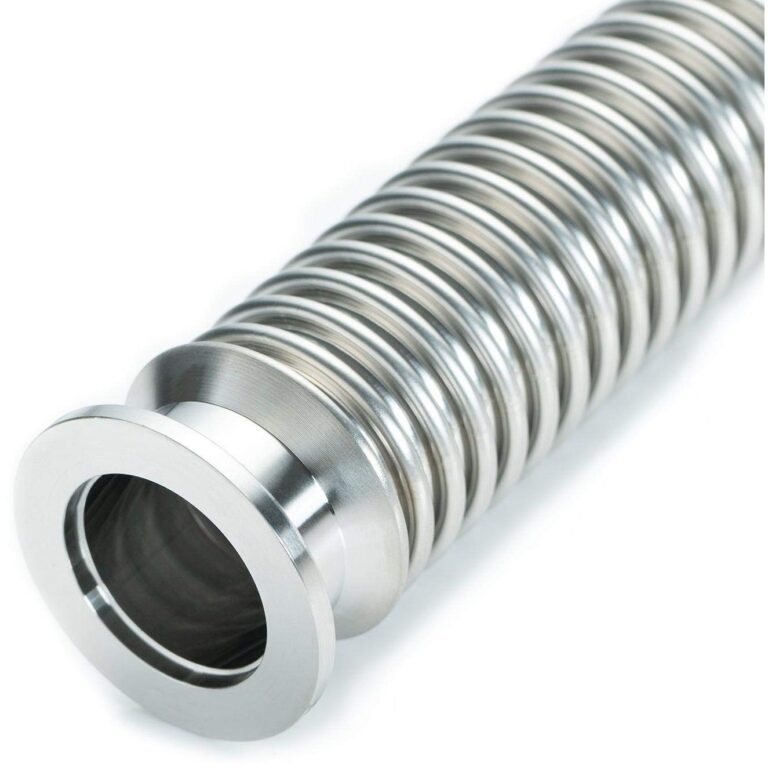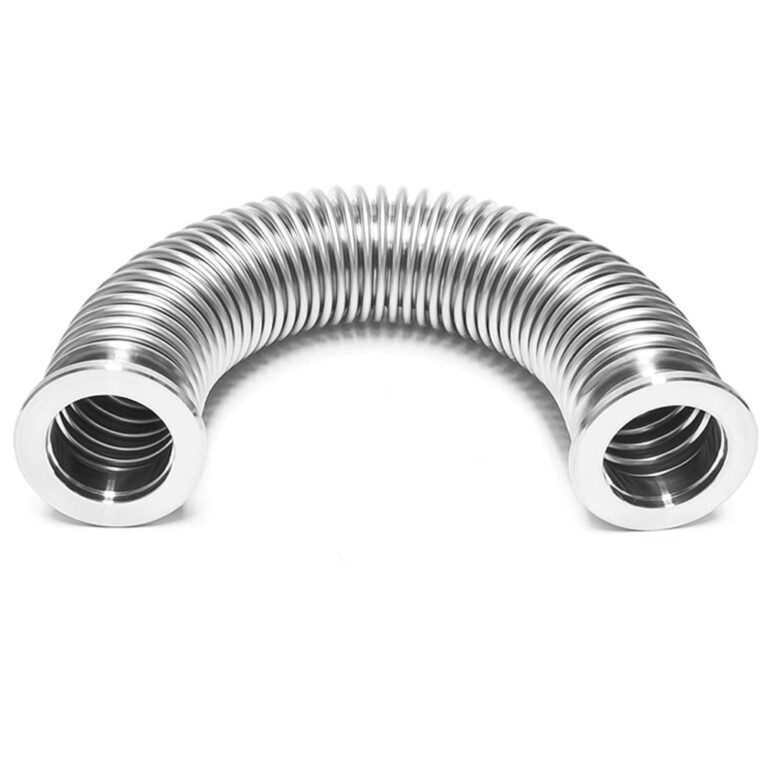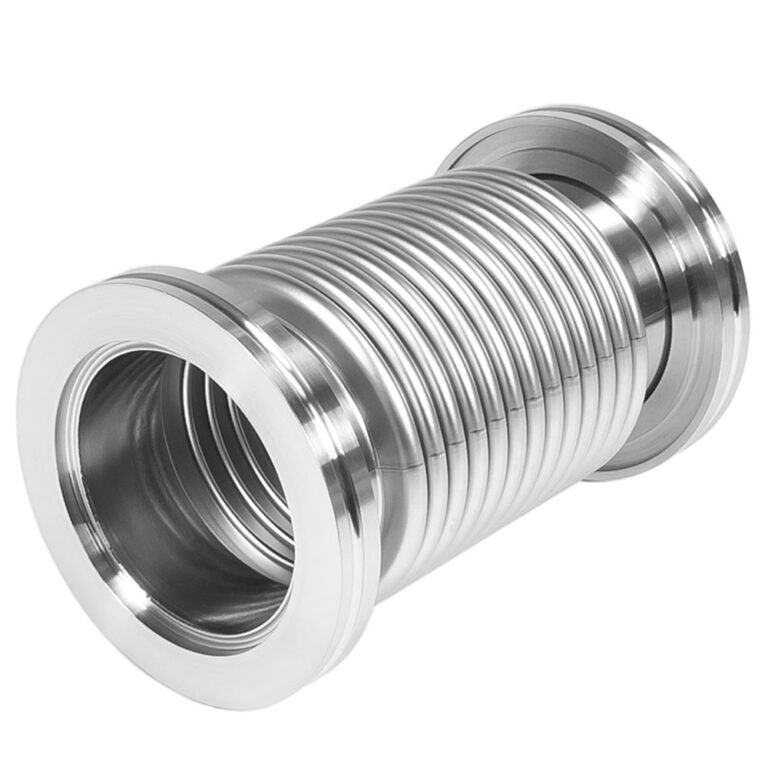SS Flex Hose
SS Bellows
SS Bellows
The stainless steel bellows are the most significant element of the expansion joint. This thin-walled, corrugated membrane permits flexibility in an exceedingly piping system containing pressure and media. Once complete, every bell incorporates a distinctive working pressure, spring rate, and cycle life based on its quality and material. Expansion Bellows will vibrate from every internal fluid flow and outwardly mechanical vibrations. At high flow, velocities and flow elicited resonance produces bellows fatigue. Two or more bellows are less effective to vibration failures due to the damping factor of the interaction of friction.
Metal expansion joints (MEJ) can also be signified as compensators or metallic bellow. An expansion joint/bellow featuring employed in a piping system is a combination of usually more than one convolute in series with the structure of the convolution designed to bear the internal pressures of bellows, thermal expansion, mechanical vibrations of different pumps, compressors, turbines component, motors, vessels and other plant components. Still, they are quite flexible in accepting axial, lateral, and angular deflections. They are mainly compromises’ of one or more metal bellows.
The SS bellows are the most significant element of the expansion joint. This thin-walled, corrugated membrane permits flexibility in an exceedingly piping system containing pressure and media. Once complete, every bell incorporates a distinctive working pressure, spring rate, and cycle life based on its quality and material. Expansion Bellows will vibrate from every internal fluid flow and outwardly mechanical vibrations. At high flow, velocities and flow elicited resonance produces bellows fatigue. Two or more bellows are less effective to vibration failures due to the damping factor of the interaction of friction.
Metal expansion joints (MEJ) can also be signified as compensators or metallic bellow. An expansion joint/bellow featuring employed in a piping system is a combination of usually more than one convolute in series with the structure of the convolution designed to bear the internal pressures of bellows, thermal expansion, mechanical vibrations of different pumps, compressors, turbines component, motors, vessels and other plant components. Still, they are quite flexible in accepting axial, lateral, and angular deflections. They are mainly compromises’ of one or more metal bellows.
It must:
.
Ensure corrosion resistance.
Provide sufficient flexibility for the purpose.
Include good squirm stability.
The applications of SS bellows are:
Handling fine substances.
Absorbing torque and material handling.
Dismantling pipelines.
Vibration absorption.
Absorb Thermal Expansion misalignment of the channel.
Deferential pressure.
These are generally used to accommodate or absorb the thermal movements of the ducts or pipes due to heat and pressure. Stainless Steel bellows are specially designed to care for these types of activities specifically. They are additionally capable of absorbing duct or pipe arrangement altogether in three directions via the Axial, Lateral & last one is Angular or combination you can say all of three.
Movements & Spring Rates: Three common types of movements are related bellows. These are Axial, Lateral, and Angular. These are respective spring rates – Axial spring rate, Lateral spring rate, and Angular spring rate. The spring rate of a bellows is entirely feasible on bellows structure drawing and material properties.
Axial Movement (+/??? MM): Axial movement is the modification in the featured dimensional type of length of the different bellows from its certain free size with the whole completely in various directions which is parallel to its substantial longitudinal axis.
Lateral Movement (+/??? MM): this type of unremarkable displacement of the two ends of bellows that area unit Joint perpendicular to its longitudinal axis. This has been named lateral offset, lateral movement, parallel arrangement, direct shear or crosswise movement.
Angular Movement (+/??? Degrees): this sort of displacement of the longitudinal axis of the enlargement Joint from its front line position into a circular arc.
NOTE – Compression is often expressed as negative and extension as positive (+)—the units for axial spring rates displayed in N/mm.
Types of Expansion Joints:
Axial Expansion Joint
Lateral Expansion Joint.
Hinge Expansion Joint.
Gimbal Expansion Joint.
Inline Pressure Balanced Expansion Joint.
Elbow Pressure Balanced Expansion Joint.
Externally Pressurized Expansion joint.
Two-ply testable bellow.
Rectangular Expansion Joint.
Slip Type Expansion Joint.
Universal Expansion Joint.
Lateral Expansion Joints
It is also called Parallel Offset and Transverse. These joints are commonly known as tied lateral expansion Joints or universal expansion joints. If it absorbs many lateral deflections, the universal expansion joints having two bellows are connected by a centre spool. The tie rods are then attached to the outer ends for maximum deflection absorption. In this type of expansion joint, the length of the centre spool (centrepiece) plays a major role.
Hinged Expansion Joints
The hinge or angular expansion joints are used where the angular movement is only in one place. These expansion joints bellows are generally used in sets where the piping direction changes. Due to the hinged nature of these expansion joints below, only angular movement is allowed around the hinges.
Axial Expansion Joints
The one-piece metal manufacture stainless steel bellow expansion joint is the best for the affordable launch where the small thermal types of movements are really affected.
Gimble Expansion Joints
The gimbal expansion joint hardware operates like the coupling on a drive shaft to accommodate angular movements in any plane. They are similar to the hinged universals, except that the two expansion joints are gimbal kind.
It contains two hinge pins, the axis of every hinge being perpendicular to the opposite one. Each set of pins is connected to every alternative with a central gimbal ring.
Rectangular expansion joints
Rectangular joints are generally used in air mass ducting to absorb thermal growth, the addition of flexibility briefly runs, and as vibration absorbers adjacent to fans, blowers and alternative mechanical machinery. They are generally used in the same manner as the corresponding circular Joint. They have applications within the cement, power, organic compound, refining, chemical and steel industries. The main options of these expansion joints are that they absorb axial and lateral movements, absorb displacements due to thermal expansion, balance pressure thrust remains constant, and eliminate main anchors.
Universal Expansion Joints
The main purpose of this structure is to settle for giant amounts of lateral deflection. The quantity of lateral deflection they can pay depends on the part of angulation each bellows can absorb and the distance between the bellows.
Slip Type Expansion Bellow
Slip type pipe expansion joints are used when the general problem could be a large axial movement. Materials would be elected to accommodate high temperatures and pressures. The structural design details include the selection of packing and seals that may be resistant to abrasive solids, and some applications could need surfaces to reduce abrasive wear. Special options like “wipers” will be enclosed to forestall potential impeding of the house provided for slip movement.
Two-Ply Testable Bellow
The ss flexible bellow is meant such that every ply will be ready to take up the complete load severally. Additionally, the expansion joints are fitted with a pressure gauge monitor that can indicate the failure of the inner ply.
Passive monitor
This monitor can solely indicate the failure in the associate inner ply.
Active monitor
This monitor will observe failures on each, inner- and also the outer ply. A vacuum is made between the inner and also outer ply before putting in this monitor. If the inner ply fails, the pressure between the plies can activate the monitor. If the outer ply does not work properly, the monitor gets active by the loss of vacuum.
Externally Pressurized Expansion joint.
Externally pressurized joints are the kind of joints that could be an excellent solution, once the joints should absorb, it increases the axial movements beneath air mass. External pressurizing of the bellows removes pressure instability as a style limitation and allows the absorption of enormous axial compression.
Elbow Pressure Balanced Expansion Joint.
This elbow pressure balanced pipe growth joint is completely a mixture of various varieties. Its aim is to retain and balance the pressure thrust so main anchoring of the pipe or adjacent instrumentality isn’t needed, and forces and movements on attachment flanges of various instrumentality, like turbines, that area unit unbroken to stay at low levels. The deflections to be accepted are handled by the correct form of pipe growth joint that typically, maybe a tied universal kind to just accept lateral movements. However, the pressure-balanced elbow is mostly needed as a result of axial deflections also are exists.
Inline Pressure Balanced Expansion Joint.
In-line pressure balanced Joint is meant to soak up axial movement and/or lateral deflection whereas restraining the pressure thrust by means that devices interconnecting the road bellows with outboard compensating bellows are additionally subjected to line pressure. Stable at high pressures.
• Eliminates change in pressure.
• No main anchors required.
• Conserves space
| Dimensions | Specifications | ||
|---|---|---|---|
| Minimum Order | 01 | ||
| Shape | Circular, Rectangular, Square | ||
| Temperature | -100C TO +900C | ||
| Grades | SS 304, 316, 316L,321, 321L | ||
| Applications | Chemical, Water, Gas, Steam, Food grade etc. | ||
| Sizes | 1.5mm – 2100mm(as per order) | ||
| ID | 25NB – 1500NB | ||
| Thickness | 0.2mm – 0.5mm | ||
| Standards | DIN, ANSI, GB,JIS | ||
| Layer/Ply | Single, Double, Triple | ||





